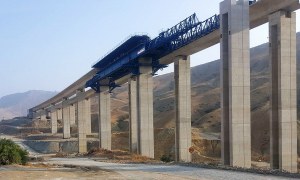🕑 Reading time: 1 minute
Contents:
Materials Used in Bridge Construction
Stones, Timber, Concrete and Steel are the traditional materials that are used to carry out bridge construction. During the initial period, timber and stones were used in the construction, as they are directly obtained from nature and easily available. Brick was used as a subgroup construction material along with stone construction. Stones as construction materials were very popular because of its durable properties. Many historic bridges made from stones are still present as a symbol of past architectural culture. But some of the timber bridge have been washed away or are in the stage of degradation due to their exposure to the environmental conditions. As time passed, the bridge construction has undergone more development in terms of materials used for construction than based on the bridge technology. The concrete and steel are manmade refined materials. The bridge construction with these artificial materials can be called the second period of the bridge engineering. This hence was the start of modern bridge engineering technology. Modern bridges make use of concrete or steel or in combination. Different other innovative materials are being developed so that they can well suit with the bridge terminologies. Incorporation of fibers which comes in the category of high strength gaining materials is now incorporated for the construction of bridges. These materials are also used in order to strengthen the existing bridges.Stones for Bridge Construction
For a long time in the history, the stone has been used in and as a single form. They are mainly used in the form of arches. This is because they possess higher compressive strength. The use of stones gave the engineers ease of constructing bridges that are aesthetically top and high in durability. When considering the history of bridge construction with stones, the Romans were the greatest builders of bridges with stones. They had a clear idea and understanding of the load over bridge, the geometry as well as the material properties. This made them construct very larger span bridges when compared with any other bridge construction during that period. The period was also competitive for Chinese. China had also developed large bridge called the famous Zhuzhou Bridge. The Zhuzhou bridge is the world’s known oldest open-spandrel, stone and segmental arch bridge. Nihonbashi is the most famous stone bridge in Japan. This is called as the Japan Bridge.
Fig.1: The Zhuzhou bridge, China
With time, the stone bridges have proved most efficient and economical due to the durability and low maintenance guaranty it provides throughout its life period.Timber or Wood for Bridge Construction
The wood material was used highly in the construction of bridges, unlike today, where it is used for the construction of building works and related. Nowadays, steel and concrete grant a higher range of work flexibility, that the use of wood and timber for mega works diminished. But, there are innovations related to the preservation of wood, which has helped to increase the demand of wood in structures. Wood as an engineering material has the advantage of high toughness and renewable in nature. They are obtained directly from nature and hence are environmentally friendly. The low density of wood makes it gain high specific strength. They have an appreciable strength value with a lower value of density. This property makes them be transported easily. Some of the disadvantages related to wood as a construction material are that it is:- Highly Anisotropic in Nature
- Susceptible to termites, infestations, and woodworm
- Highly combustible
- Susceptible to rot and disease
- Cannot be used for High temperature

Fig.2: The Mathematical Bridge, Cambridge

Fig.3. The Togetsu-Kyo Bridge, Japan
Steel for Bridge Construction
Steel gain high strength when compared with any other material. This makes its suitable for the construction of bridges with longer span. We know that steel is a combination of alloys of iron and other elements, mainly carbon. Based on the amount and variation of the elements, the properties of the same is altered accordingly. The properties of tensile strength, ductility and hardness are influenced by the change in its constitution. The steel used for normal construction have several hundred Mega Pascal strength. This strength is almost 10 times greater than the compressive and the tensile strength obtained from a normal concrete mix. The major inbuilt property of steel is the ductility property. This is the deformation capability before the final breakage tends to happen. This property of steel is an important criterion in the design of structures.
Fig.4. The Hachimanbashi Bridge
The first iron bridge, Danjobashi Bridge which was built in 1878 in Japan. The figure-4 below shows the Danjobashi Bridge. Danjobashi Bridge was relocated to the present location and was named as Hachimanbashi Bridge in 1929. It has great historical and technical value as a modern bridge. The bridge was honored by the American Society of Civil Engineers in the year 1989. The chemical composition and the method of manufacture determines the properties of structural steel. The main properties that are to be specified by the bridge designers when it is required to specify the products are:- Strength
- Toughness
- Ductility
- Durability
- Weldability


